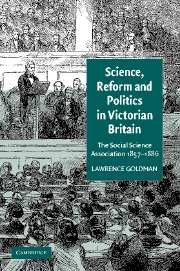Book contents
- Frontmatter
- Contents
- List of illustrations
- Acknowledgements
- Note on citations in the text
- List of abbreviations
- Introduction: the contexts of the Social Science Association
- Part I POLITICS
- Part II REFORM
- Chapter 4 Liberalism divided and feminism divided: women and the Social Science Association
- Chapter 5 Transportation, reformation, and convict discipline: the Social Science Association and Victorian penal policy 1853–1871
- Chapter 6 Victorian socio-medical liberalism: the Social Science Association and state medicine
- Chapter 7 Labour and capital: the Social Science Association, trade unionism, and industrial harmony
- Chapter 8 The Social Science Association and middle-class education: secondary schooling, endowments, and professionalisation in mid-Victorian Britain
- Chapter 9 The Social Science Association and the making of social policy
- Part III SCIENCE
- Part IV DECLINE
- Conclusion: The Social Science Association and social knowledge
- Appendix I The founders of the Social Science Association, 29 July 1857
- Appendix II Social Science Association Congresses, 1857–1884
- Appendix III Presidents of the Social Science Congresses, 1857–1884
- Appendix IV Departmental presidents, 1857–1884
- Select bibliography
- Index
Chapter 4 - Liberalism divided and feminism divided: women and the Social Science Association
Published online by Cambridge University Press: 22 September 2009
- Frontmatter
- Contents
- List of illustrations
- Acknowledgements
- Note on citations in the text
- List of abbreviations
- Introduction: the contexts of the Social Science Association
- Part I POLITICS
- Part II REFORM
- Chapter 4 Liberalism divided and feminism divided: women and the Social Science Association
- Chapter 5 Transportation, reformation, and convict discipline: the Social Science Association and Victorian penal policy 1853–1871
- Chapter 6 Victorian socio-medical liberalism: the Social Science Association and state medicine
- Chapter 7 Labour and capital: the Social Science Association, trade unionism, and industrial harmony
- Chapter 8 The Social Science Association and middle-class education: secondary schooling, endowments, and professionalisation in mid-Victorian Britain
- Chapter 9 The Social Science Association and the making of social policy
- Part III SCIENCE
- Part IV DECLINE
- Conclusion: The Social Science Association and social knowledge
- Appendix I The founders of the Social Science Association, 29 July 1857
- Appendix II Social Science Association Congresses, 1857–1884
- Appendix III Presidents of the Social Science Congresses, 1857–1884
- Appendix IV Departmental presidents, 1857–1884
- Select bibliography
- Index
Summary
‘When at some future day women look back from the serene heights of freedom and equality upon the difficult and painful steps which led thither, they will gratefully acknowledge the aid which its meetings have afforded to their cause.’ So wrote the Englishwoman's Review about the Social Science Association. In an emergent women's movement without a single institutional focus, and divided into different campaigns, the SSA came as close as any organisation to representing women in public. It is credited with legislative successes – among them the Married Women's Property Act of 1870 – and practical advances in women's social position. It was a platform where women could present their ideas on the development of their interests not only to a proximate audience of supportive feminists – men as well as women – but to more sceptical national audiences requiring persuasion.
Yet this uncomplicated picture of the relationship between mid-Victorian social science and feminism, though generally accurate, masks tensions between groups of women and other constituencies at the Social Science Association, and among women themselves. There were disagreements over the nature of women's participation in society, over methods women might employ to raise their status, and over the very women's questions to be considered at the Association. Divisions over the issue of the Contagious Diseases Acts brought some women into conflict with erstwhile allies at the SSA.
- Type
- Chapter
- Information
- Science, Reform, and Politics in Victorian BritainThe Social Science Association 1857–1886, pp. 113 - 142Publisher: Cambridge University PressPrint publication year: 2002



